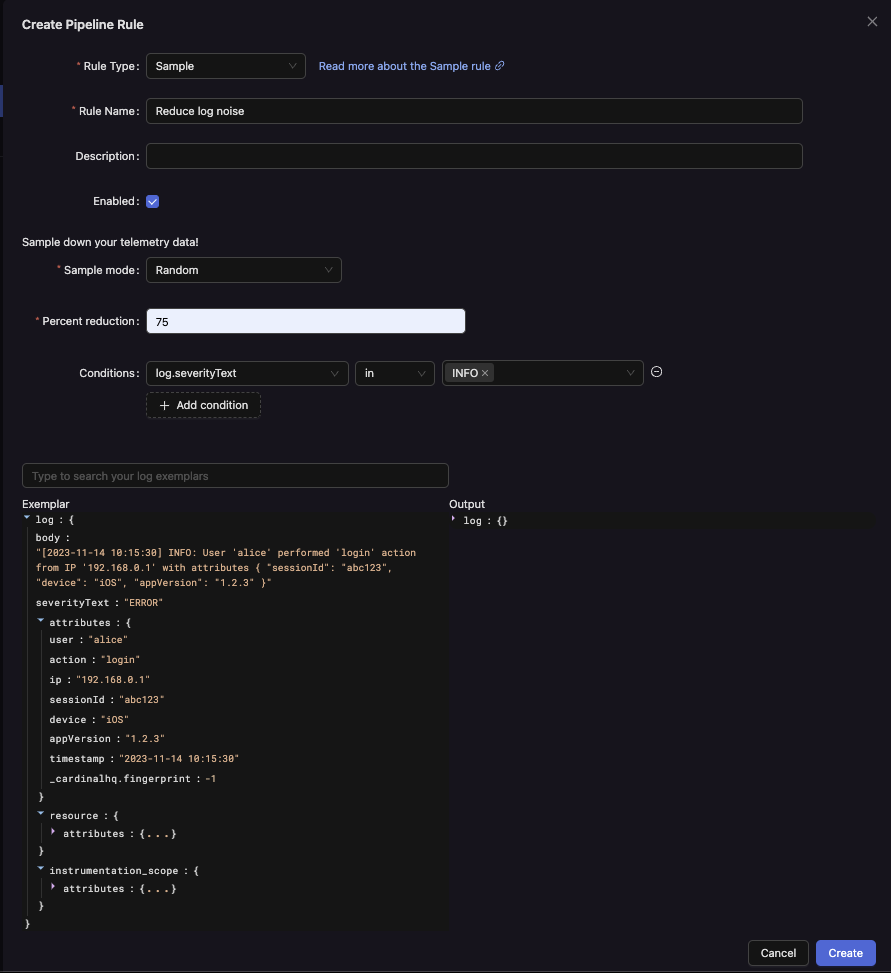Sampling Telemetry Data
Overview
The Sample Rule helps you control the volume of your log telemetry data by reducing its quantity before it's stored or sent to downstream analytics tools. High-volume or "noisy" logs can quickly drive up costs and overwhelm your monitoring systems, making it harder to spot key issues. By sampling the data—either randomly or proportionally—you maintain a representative set of logs without all the excess.
What Does This Rule Do?
The Sample Rule inspects incoming log entries and decides which ones to keep based on your chosen sampling strategy and specified conditions. The key parameters include:
- Sample Mode: Choose how you want to sample (randomly or proportionally).
- Percent Reduction: Define the percentage by which you want to reduce the volume of logs.
- Conditions (Optional): Apply filtering conditions so that only certain logs are sampled, while others remain untouched.
Example Use Cases:
- Randomly sample only 10% of all logs to significantly reduce ingestion volume.
- Proportionally sample logs so that both common and less frequent log messages are represented according to their relative frequencies.
- Apply sampling conditions to only reduce logs from a particularly noisy service while keeping critical logs from other services intact.
Key Features
- Cost Management: Sampling helps keep ingestion and storage costs in check, as you only retain a subset of the raw data.
- Preserved Insights: With careful tuning, you can maintain enough coverage to identify trends and anomalies without being swamped by unnecessary volume.
- Flexible Conditions: Use conditions to limit sampling to specific attributes (e.g., certain services, environments, or error codes). This ensures that critical logs remain fully captured, while non-essential ones are thinned out.
- Adaptable Methods:
- Proportional Sampling: Ensures that frequently occurring log types are still well-represented after sampling.
- Random Sampling: Offers a straightforward way to reduce volume regardless of log frequency.
Options and Parameters
Example:

Sample Mode
Proportional: Retains a representative distribution of your logs. High-frequency logs are reduced proportionally, but still maintain a semblance of their original frequency relative to less common logs.
Random: Simply keeps a fixed percentage of logs at random, without regard to their frequency or content.
Percent Reduction
Specify the percentage by which you want to reduce your log volume. For example, a 90% reduction means that only 10% of your logs will be kept. This value can be fine-tuned based on desired cost savings and the level of detail you need in your monitoring data.
Conditions (Optional)
Add conditions to apply sampling selectively. For example, you can:
- Only sample logs from a certain
service.name. - Reduce logs with a specific
environment = "staging"but keep production logs intact. - Throttle noisy
debuglevel logs while preserving allerrorlevel logs.
If no conditions are specified, the sampling rule applies to all incoming logs.
Example Configuration
Goal: Randomly sample logs to achieve a 50% reduction, but only for a noisy microservice in staging.
Configuration Steps:
- Sample Mode: Random
- Percent Reduction:
50(keep 50% of logs) - Conditions:
attributes[“service.name”] = “staging-microservice”Result: Only the logs from the staging-microservice are randomly sampled down to half their original volume. All other logs continue to flow at full volume.
Testing and Verification
- Start with a small reduction: Begin with a mild sampling rate (e.g., 10%) and verify that you still see meaningful patterns and trends.
- Adjust Conditions: Narrow or broaden your conditions based on test results. If too much important data is lost, reduce the sampling rate or remove certain conditions.
- Monitor Metrics: Evaluate downstream dashboards and alerts to ensure that crucial insights remain visible despite reduced data volume.
Summary
By implementing a Sample Rule, you gain control over log volume and costs, ensuring that your observability platform remains both efficient and insightful. Whether you choose a random approach for simplicity or a proportional approach to maintain representativeness, sampling empowers you to keep essential data visible while reducing unnecessary noise. This leads to cost savings, clearer insights, and a more maintainable telemetry ecosystem.